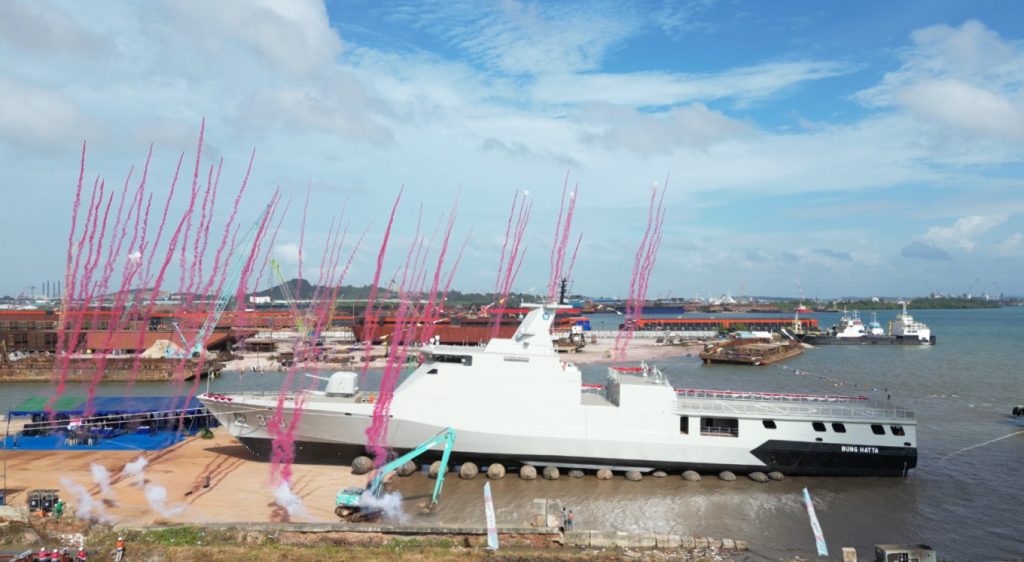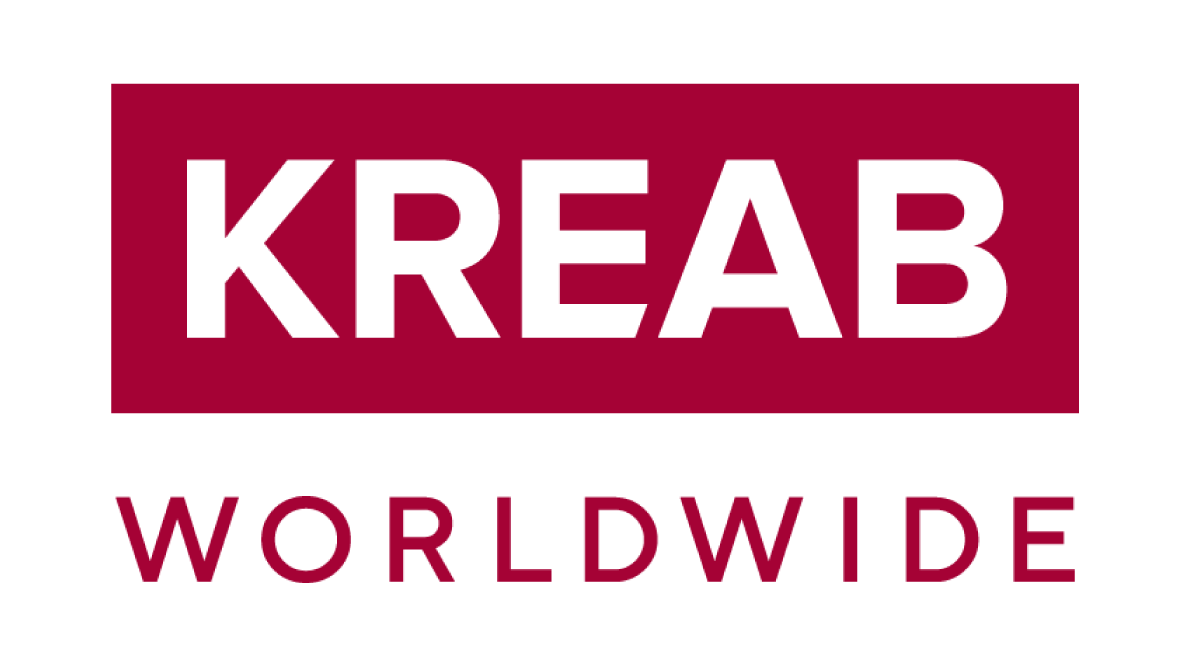Frigates equipped with long-range firepower and advanced sensors, alongside heavyweight corvettes are expected to spearhead Indonesia’s blue-water fleet capable of sustained Indo-Pacific operations.

Fireworks accompany the launch of the Indonesian Navy’s newest warship, the KRI Bung Hatta corvette on Feb. 27 at PT Karimun Anugrah Sejati shipyard in Batam, Riau Islands. Navy chief of staff Adm. Muhammad Ali launched the second ship from the domestically built Bung Karno-class corvette. (Courtesy of Indonesian Navy/-)
On Sept. 8, a striking man-of-war with a wave-piercing double bow and an imposing bridge, unlike anything in the Indonesian Navy (TNI AL) fleet, docked at Jakarta’s Tanjung Priok Naval Base. Greeted by Defense Minister Sjafrie Sjamsoeddin and Indonesian Military (TNI) Commander Gen. Agus Subiyanto, KRI Brawijaya-320 carries a Majapahit-inspired name that speaks to Indonesia’s storied maritime past.
Its arrival from Italy marks a bold new chapter. The first of two Thaon di Revel-class (PPA) frigates from Fincantieri, with sister ship KRI Prabu Siliwangi expected to arrive in January 2026, KRI Brawijaya is the TNI-AL’s first newly built surface combatant of this scale in over four decades. Together with two Merah Putih frigates under construction at state ship builder PT PAL in Surabaya for delivery in 2026-2027, these 6,000-ton vessels will stand as the Navy’s most capable warships.
KRI Brawijaya marks a significant leap in tonnage and capabilities compared to prior acquisitions. For decades, the Navy’s largest surface combatants were the 2,835-ton Ahmad Yani-class frigates, purchased second-hand from the Dutch in the 1980s. More recently, the 2,365-ton Martadinata-class, built between 2014 and 2020, were hailed as advanced but remained light frigates derived from corvette designs.
In naval warfare, as the old saying goes, size does matter.
The PPA and Merah Putih programs embody TNI AL’s shift from a coastal defense force reliant on aging corvettes and frigates to a blue-water navy ambition targeting 2034. The naval force also aligns with the Defense Ministry’s 2020-2024 Strategic Plan, which prioritized cyber defense and maritime security in the Natuna Sea.
Equipped with mid- to long-range anti-air warfare systems (AAW), a major upgrade from the Navy’s current short-range AAW, alongside advanced sensors and electronic warfare capabilities, these ships are designed for contested waters such as the South China Sea.
Yet capability alone does not define strategy. While the next Strategic Plan (2025–2029) has yet to be published, TNI AL has declared its mid-term objective: establishing credible regional deterrence.
This goal will likely be pursued through the addition of around 20 new warships to the Navy’s existing fleet of approximately 165 vessels. This would complete the long-delayed phase III of the Minimum Essential Force program, the defense modernization roadmap set for 2009-2024.
At the same time, the Navy plans to retire its aging five Ahmad Yani-class frigates and 14 Parchim-class corvettes, workhorses of the fleet for more than 30 years.
Looking ahead, Indonesia will likely pursue more capital ships comparable to KRI Brawijaya in terms of displacement or capabilities. Frigates exceeding 4,000 tons, equipped with long-range firepower and advanced sensors, alongside heavyweight corvettes with sophisticated anti-submarine warfare systems, are expected to spearhead a blue-water fleet capable of sustained Indo-Pacific operations, well beyond Indonesia’s Exclusive Economic Zone.
The question is not whether TNI AL will expand, but how. Since the mid-2000s, the Defense Ministry, not the services, has controlled procurement of major weapon systems, aligning acquisitions with national priorities and budgets, but often overruling the Navy’s preferences.
In 2006, the ministry directed the purchase of Dutch Sigma 9113 Diponegoro-class corvettes, rejecting TNI AL’s choice of Russia’s Steregushchiy-class. In 2018, it slashed the PKR (Sigma 10514) program from six to two units, shifting resources to the Merah Putih frigate program based on Denmark’s Iver Huitfeldt-class, while sidelining the Navy’s objections over the evolving choice of combat management system (CMS), from French Thales to Danish Terma and finally Turkish Havelsan when President Prabowo assumed the role of the defense minister under the previous administration.
KRI Brawijaya itself reflects this dynamic. Prabowo, impressed by the Bergamini-class (FREMM), initially pushed for acquisition of the Italian and French navies’ most powerful frigate. When the negotiation stalled, likely due to budget, he settled for the less capable but readily available PPA as a stopgap.
In addition, he has also entertained options once unthinkable: South Korea’s KDDX destroyers, China’s Type 052D destroyers and even Japanese Mogami-class stealth frigates. His procurement style blends pragmatism, opportunism, and ambition.
Now, as president, Prabowo’s influence looms even larger. It is thus unsurprising that we hear of increasingly ambitious plans, including TNI AL’s reported intention to procure the 40-year-old Italian aircraft carrier Giuseppe Garibaldi.
We cannot avoid the impression of poorly planned defense procurement, particularly in the naval sector. Yet Prabowo’s willingness to source from diverse suppliers has reshaped the defense industry landscape. Thales, once dominant in sensors and CMS, now faces serious competition from Leonardo, which broke into the market of TNI AL’s capital ships through the PPA deal.
Meanwhile, Turkey, backed by generous offset and technology-transfer packages, has emerged as a formidable contender across systems and platforms, effectively breaking the long-standing tradition of supplier consolidation in CMS and sensors.
In modern naval warfare, these systems are the defining factor in a fleet’s capability. For decades, Thales has dominated CMS and sensors on major warships, while Terma maintained its hold on smaller vessels.
This growing competition among contractors and vendors creates leverage for the Defense Ministry to secure the best deals, not just pricing but, more critically, robust offset and technology transfer packages. The €1.18 billion (US$ 1.37b) PPA deal reportedly included an extensive offset package to strengthen Indonesia’s defense industry. Whether such promises translate into real capabilities, however, remains an open question.
If KRI Brawijaya symbolizes anything, it is that Indonesia’s naval rise will be forged as much in negotiation rooms as at sea. Prabowo’s continuing influence ensures that naval procurement will remain pragmatic, impulsive at times, expansive when budgets allow and driven by the pursuit of the most powerful platforms available from any willing supplier.
The real challenge is ensuring this ambition delivers more than just impressive hulls but also builds a stronger domestic defense industry as a cornerstone of a sustainable fleet structure capable. Without this, the Navy risks sailing into the Indo-Pacific with bigger ships but a fragile foundation.*
Rahmad Budi Harto is the lead consultant at the public affairs firm Kiroyan Partners. The views expressed are personal.
Source: The Jakarta Post, September 19, 2025.
Download the clipping here.



